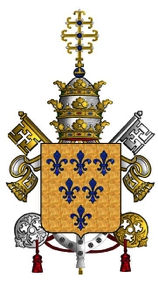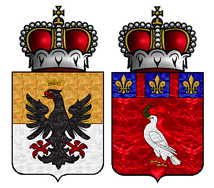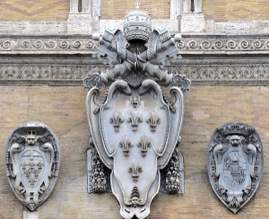With the Pamphili we see even more layers and hybridization: As previously mentioned, family crests are often emblazoned with a crown, without either the miter or cardinal’s elaborate hat. All of these noble families abounded with intermarriages with other Italian noble families. For instance, the House of Pamphili princes joined forces with the princes of the House of Doria of the great seafaring family from Genova. They then intermarried with the House of Landi, complicating the family stemma even further. The House of Landi comes from a town outside of Rome and the family was granted the title of prince. What machinations to get prestige and stature. If not actually Papal, the crown above the seal was the next best thing.
FARNESE
Before I close my story two other families cannot be left out of the many more I could highlight. One is the Farnese family and Pope Paul III Farnese (1468–1549). Their coat of arms, or stemma, is composed of six lilies and not to be confused with the three lilies for the Kings of France. For the French the lily means the divine rule of right, but the lily outside of the French context is a flower that means perfection, purity, and courage. At different times over the course of history, the fleur-de-lis has represented peace, war, strength, and nobility to name a few.
Page 10
Click monogram to return to home page




+
=
Doria Pamphili Landi House of Doria Pamphili Landi


Pope Paul III Farnese, Titian 1543
Farnese crest over the main entrance, Palazzo Farnese, Piazza Farnese, Rome